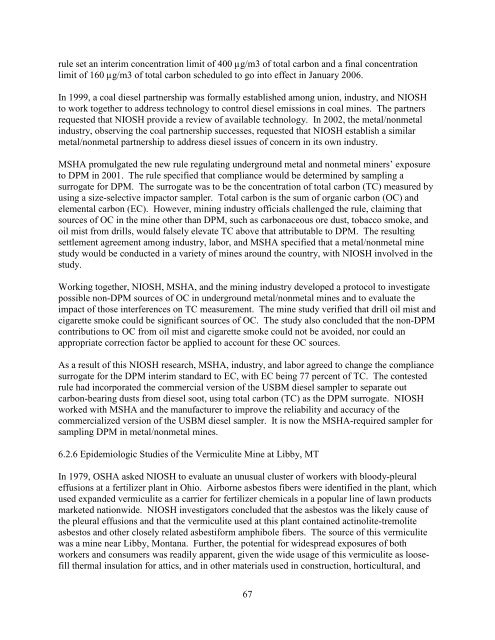One Hundred Years of Federal Mining Safety and Health Research
One Hundred Years of Federal Mining Safety and Health Research
One Hundred Years of Federal Mining Safety and Health Research
- No tags were found...
Create successful ePaper yourself
Turn your PDF publications into a flip-book with our unique Google optimized e-Paper software.
ule set an interim concentration limit <strong>of</strong> 400 µg/m3 <strong>of</strong> total carbon <strong>and</strong> a final concentration<br />
limit <strong>of</strong> 160 µg/m3 <strong>of</strong> total carbon scheduled to go into effect in January 2006.<br />
In 1999, a coal diesel partnership was formally established among union, industry, <strong>and</strong> NIOSH<br />
to work together to address technology to control diesel emissions in coal mines. The partners<br />
requested that NIOSH provide a review <strong>of</strong> available technology. In 2002, the metal/nonmetal<br />
industry, observing the coal partnership successes, requested that NIOSH establish a similar<br />
metal/nonmetal partnership to address diesel issues <strong>of</strong> concern in its own industry.<br />
MSHA promulgated the new rule regulating underground metal <strong>and</strong> nonmetal miners’ exposure<br />
to DPM in 2001. The rule specified that compliance would be determined by sampling a<br />
surrogate for DPM. The surrogate was to be the concentration <strong>of</strong> total carbon (TC) measured by<br />
using a size-selective impactor sampler. Total carbon is the sum <strong>of</strong> organic carbon (OC) <strong>and</strong><br />
elemental carbon (EC). However, mining industry <strong>of</strong>ficials challenged the rule, claiming that<br />
sources <strong>of</strong> OC in the mine other than DPM, such as carbonaceous ore dust, tobacco smoke, <strong>and</strong><br />
oil mist from drills, would falsely elevate TC above that attributable to DPM. The resulting<br />
settlement agreement among industry, labor, <strong>and</strong> MSHA specified that a metal/nonmetal mine<br />
study would be conducted in a variety <strong>of</strong> mines around the country, with NIOSH involved in the<br />
study.<br />
Working together, NIOSH, MSHA, <strong>and</strong> the mining industry developed a protocol to investigate<br />
possible non-DPM sources <strong>of</strong> OC in underground metal/nonmetal mines <strong>and</strong> to evaluate the<br />
impact <strong>of</strong> those interferences on TC measurement. The mine study verified that drill oil mist <strong>and</strong><br />
cigarette smoke could be significant sources <strong>of</strong> OC. The study also concluded that the non-DPM<br />
contributions to OC from oil mist <strong>and</strong> cigarette smoke could not be avoided, nor could an<br />
appropriate correction factor be applied to account for these OC sources.<br />
As a result <strong>of</strong> this NIOSH research, MSHA, industry, <strong>and</strong> labor agreed to change the compliance<br />
surrogate for the DPM interim st<strong>and</strong>ard to EC, with EC being 77 percent <strong>of</strong> TC. The contested<br />
rule had incorporated the commercial version <strong>of</strong> the USBM diesel sampler to separate out<br />
carbon-bearing dusts from diesel soot, using total carbon (TC) as the DPM surrogate. NIOSH<br />
worked with MSHA <strong>and</strong> the manufacturer to improve the reliability <strong>and</strong> accuracy <strong>of</strong> the<br />
commercialized version <strong>of</strong> the USBM diesel sampler. It is now the MSHA-required sampler for<br />
sampling DPM in metal/nonmetal mines.<br />
6.2.6 Epidemiologic Studies <strong>of</strong> the Vermiculite Mine at Libby, MT<br />
In 1979, OSHA asked NIOSH to evaluate an unusual cluster <strong>of</strong> workers with bloody-pleural<br />
effusions at a fertilizer plant in Ohio. Airborne asbestos fibers were identified in the plant, which<br />
used exp<strong>and</strong>ed vermiculite as a carrier for fertilizer chemicals in a popular line <strong>of</strong> lawn products<br />
marketed nationwide. NIOSH investigators concluded that the asbestos was the likely cause <strong>of</strong><br />
the pleural effusions <strong>and</strong> that the vermiculite used at this plant contained actinolite-tremolite<br />
asbestos <strong>and</strong> other closely related asbestiform amphibole fibers. The source <strong>of</strong> this vermiculite<br />
was a mine near Libby, Montana. Further, the potential for widespread exposures <strong>of</strong> both<br />
workers <strong>and</strong> consumers was readily apparent, given the wide usage <strong>of</strong> this vermiculite as loosefill<br />
thermal insulation for attics, <strong>and</strong> in other materials used in construction, horticultural, <strong>and</strong><br />
67
















